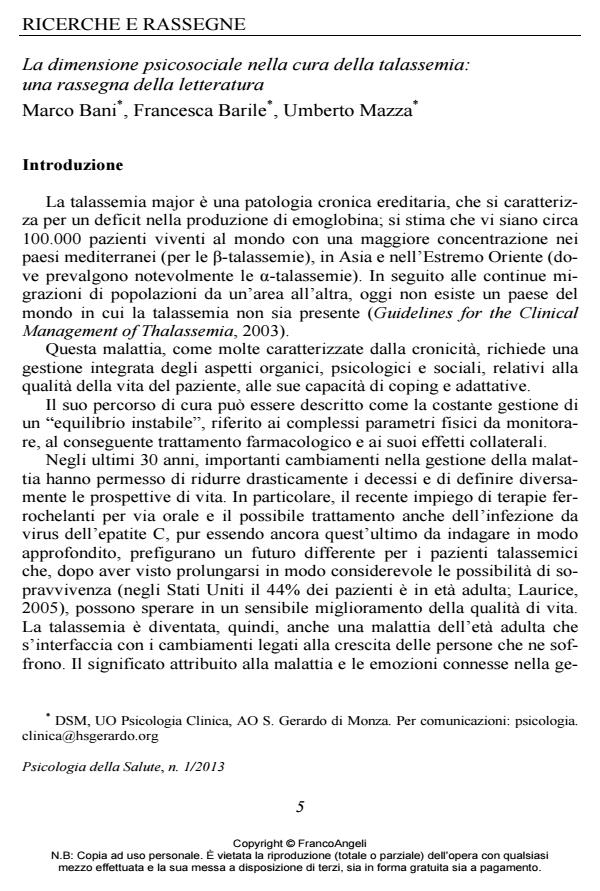La dimensione psicosociale nella cura della talassemia: una rassegna della letteratura
Titolo Rivista PSICOLOGIA DELLA SALUTE
Autori/Curatori Marco Bani, Francesca Barile, Umberto Mazza
Anno di pubblicazione 2013 Fascicolo 2013/1
Lingua Italiano Numero pagine 22 P. 5-26 Dimensione file 325 KB
DOI 10.3280/PDS2013-001001
Il DOI è il codice a barre della proprietà intellettuale: per saperne di più
clicca qui
Qui sotto puoi vedere in anteprima la prima pagina di questo articolo.
Se questo articolo ti interessa, lo puoi acquistare (e scaricare in formato pdf) seguendo le facili indicazioni per acquistare il download credit. Acquista Download Credits per scaricare questo Articolo in formato PDF

FrancoAngeli è membro della Publishers International Linking Association, Inc (PILA)associazione indipendente e non profit per facilitare (attraverso i servizi tecnologici implementati da CrossRef.org) l’accesso degli studiosi ai contenuti digitali nelle pubblicazioni professionali e scientifiche
La talassemia major è una patologia genetica, che richiede periodiche e costanti trasfusioni di sangue e un trattamento ferrochelante a vita oltre che una presa in carico multidisciplinare. Come ogni patologia cronica, determina un grosso impatto sulla qualità di vita, il benessere psicologico e il contesto familiare dei pazienti. I progressi medici degli ultimi 30 anni hanno permesso un notevole miglioramento delle aspettative di vita di questi pazienti che possono raggiungere l’età adulta, lavorare, avere dei figli a condizione di una costante adesione al trattamento. Alla luce di questi miglioramenti si propone una rassegna dei risultati di ricerca degli ultimi 10 anni, in relazione alle difficoltà psicosociali dei pazienti e dei familiari, alla qualità di vita e alla dimensione psicopatologica dei soggetti con talassemia, per verificare se tali dimensioni si siano anch’esse modificate, anche in relazione ai differenti contesti culturali. I dati emersi mostrano un livello di psicopatologia maggiore rispetto ai soggetti di controllo e una qualità di vita più bassa sia per i soggetti con talassemia sia per i familiari, indicando, pur di fronte ai miglioramenti clinici, la necessità di uno sforzo maggiore verso la progettazione e la diffusione di interventi psicosociali.
Parole chiave:Talassemia, psicopatologia, caregiver, coping, qualità di vita
Marco Bani, Francesca Barile, Umberto Mazza, La dimensione psicosociale nella cura della talassemia: una rassegna della letteratura in "PSICOLOGIA DELLA SALUTE" 1/2013, pp 5-26, DOI: 10.3280/PDS2013-001001